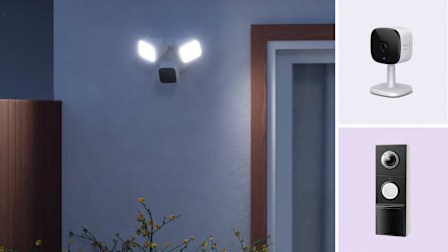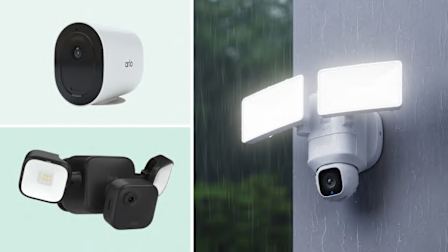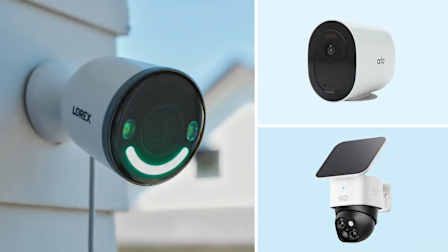How to Stop Spiders From Building Webs in Front of Your Home Security Cameras
Expert tips on preventing web-slingers from spamming your camera with nuisance alerts

With Halloween upon us, you might have decorated your home’s exterior to gear up for the frightful festivities. And if you own a floodlight security camera or spotlight camera, you might have some creepy crawlies adding their own spin to your holiday décor.
The problem is these busy builders can cause your camera to create a flurry of motion alerts and video clips that spam your smartphone all night long and drain your camera’s battery faster than Dracula could rob a blood bank. To figure out the best ways to combat this problem, we consulted with camera manufacturers Arlo, Eufy, and Ring as well as a pest control expert.
They were able to provide some tips on how to keep spider webs at bay, minimizing the flood of useless footage and nuisance alerts they create. Unfortunately, none of the solutions are perfect—in fact, some might limit the functionality of your camera. We’ve arranged the tips below from most to least helpful.
Need help combating other insects? See our guides to getting rid of ants, bed bugs, mosquitoes, and ticks.
We also recently reviewed the Arlo Pro 3 Floodlight Camera, Eufy Floodlight Camera, and Ring Floodlight Cam Wired Pro to find out if floodlight cameras are worthwhile. No spiders cozied up to the cameras during our at-home evaluation, but a number of frustrated consumers have complained about this issue on social media and manufacturer forums.
Take Advantage of Your Camera’s Smart Alerts
Many cameras now use artificial intelligence to recognize specific types of objects and alert you to them with a ping on your smartphone. These smart alerts can spot people, animals/pets, vehicles, and packages. Additionally, some cameras (such as those from Arlo and Ring) have catch-all alerts for all other motion (say, a moth buzzing around a light).
Adjust Your Camera’s Monitoring Zones
In addition to smart alerts, most cameras offer monitoring zones (also called activity zones or motion zones) that allow you to highlight certain areas that the camera “sees” to receive motion alerts from movement in those areas.
If the spider web is in a corner of the camera’s field of view, Ring suggests adjusting your zones so the web is outside the zone. This will allow the camera to essentially “ignore” the spider. Of course, this will only work as long as the spider limits the ambitions of its web-making.
Like the smart alerts, some manufacturers charge a monthly fee for this feature. A few exceptions are Eufy, Google Nest, and Ring, which offer monitoring zones for free.
Here's an example of how persistent spiders can be, from a floodlight camera at the home of Glenn Derene, a CR editor.
Turn Off or Minimize Use of Your Camera’s Lights
The main reason you might have opted for a floodlight security camera over a wireless security camera? The lights. The main reason spiders are so attracted to floodlight cameras? “It’s the lights,” says Jody Gangloff-Kaufmann, an entomologist and coordinator for community integrated pest management at Cornell University. The lights attract other bugs and seal their fate as Spidey’s dinner.
That’s why spiders often anchor their webs in doorways where interior lights shine through to the outside. “Spiders build their webs in our doorways because that is where the prey is,” says Gangloff-Kaufmann. “I don’t know how they know that, but spiders can see lights, even if their sight is poor.”
So while it’s not ideal, if spiders present a huge headache for you, you could consider turning off or limiting the use of your camera’s lights. Most cameras let you do this in the camera app’s settings, and some offer a way to schedule when the lights will be active.
For example, my backyard floodlight camera is set so its lights are only active from 11 p.m. to dawn. That way, the lights will turn on only if motion is detected in the middle of the night, in the hopefully unlikely event you need them to scare off an intruder. Of course, that time period could also be when the spider is busy spinning its web, but the decreased usage of the lights could deter it from setting up shop in the first place.
Periodically Clean Up the Webs
“If this happened to me repeatedly, I would take a broom or a stick, remove the webbing, and try to move the spider away from the house into the landscape somewhere,” says Gangloff-Kaufmann.
And don’t bother trying to go all grim reaper: Gangloff-Kaufmann says that while insecticides and peppermint oil anti-spider sprays might kill spiders on contact, more spiders will come back eventually because their residue is ineffective at getting rid of the web slingers.
“The contact that web-building spiders have with surfaces is pretty minimal,” she says, adding that they usually only touch surfaces with their tarsi (toes) and spinnerets—finger-like appendages that expel silk. Other bugs will lie flat on surfaces and make bodily contact, making them more susceptible to the residue.
“I’m kind to spiders, but not everyone has the same warm feelings for them," says Gangloff-Kaufmann. “Cleaning up the webs and removing the spiders—that is the best approach.”
































